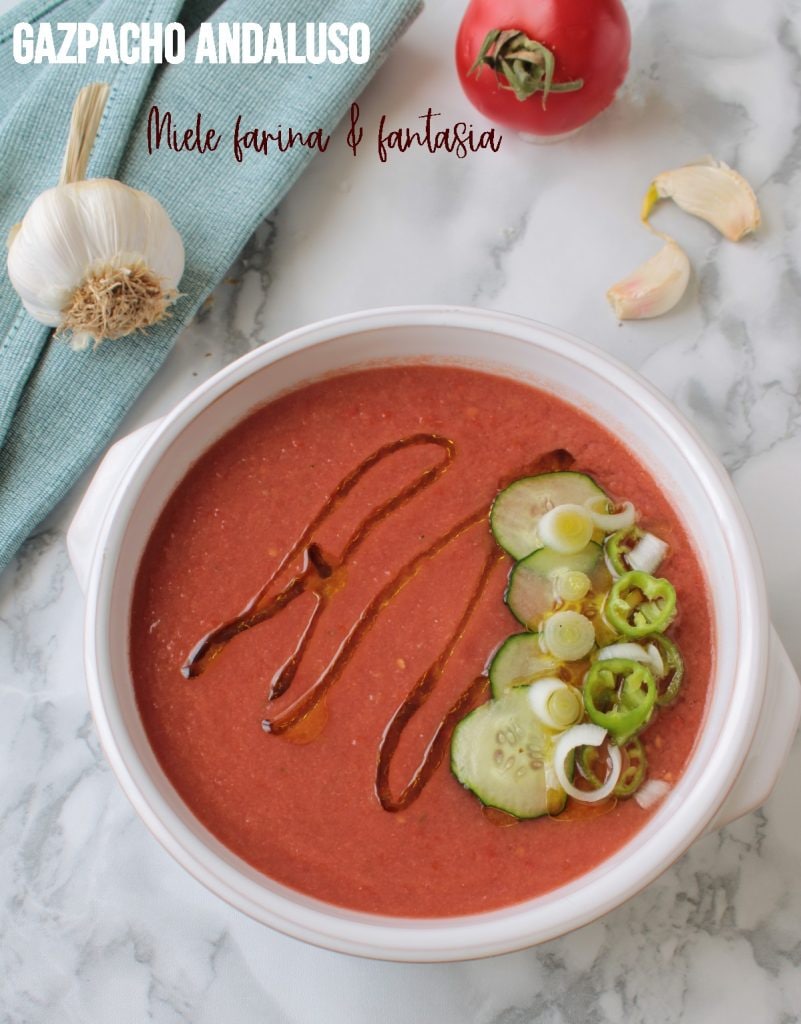Andalusian gazpacho is truly an extraordinary vegetarian dish, not only for the taste and aroma of its ingredients, which must be fresh, seasonal, and used raw, but also because it can be enjoyed as a soup or drunk as a beverage. Gazpacho, whose main ingredient is ripe red tomatoes (which our land is abundant with), must be served strictly cold; it is, therefore, a perfect remedy in summer, as it allows us to fill up on vitamins, minerals, fiber, and so on, but it’s also refreshing and light, which are important characteristics when it’s very hot. The ingredients to make this preparation are those we find daily in our kitchens, typical of Mediterranean cuisine, so they are easily available; moreover, it’s very easy and quick to prepare. Some people add bread to give more body to the gazpacho, some do not; or some use a greater quantity of one ingredient rather than another, but what matters is that the basic elements that characterize it are present; then, it will be up to us to personalize it according to our tastes and needs.

- Difficulty: Very Easy
- Cost: Economical
- Rest time: 10 Minutes
- Preparation time: 30 Minutes
- Portions: 4
- Cooking methods: No Cooking
- Cuisine: Spanish
- Seasonality: Spring, Summer
Ingredients
- 1.3 lbs ripe red tomatoes
- 7 oz cucumber
- 7 oz green bell pepper
- 1 fresh scallion
- 2 oz bread or roll (also gluten-free)
- 1 clove garlic (no inner sprout)
- to taste extra virgin olive oil
- to taste fine salt
- 1 tbsp white wine vinegar
Steps
In some recipes from Spanish websites, bread is not added to the preparation, even when the intention is to serve the gazpacho as a cold soup (thus, when more density would be needed for the cream), but served separately, as an accompaniment, in the form of croutons. It’s a matter of personal taste and choices; let’s keep in mind, however, that if we want to serve the gazpacho as a beverage, it should not be too dense, but of the right consistency to be sipped through a straw (just like a traditional smoothie, not too thick nor too liquid).
As for the tomatoes, if you add bread to the vegetable blend, you can choose not to remove the skin and seeds; in fact, thanks to the bread, the mixture will be perfectly smooth and velvety.
Otherwise, let’s do it this way: put water in a pot and heat it; it should become boiling, then turn it off. In the meantime, after washing the tomatoes, make a cross incision on the skin where the stalk is located and on the opposite side.
When the water is boiling, add the tomatoes, cover, and leave them for only 30 seconds, turning them in the boiling water from time to time. Then remove them from the water and, without burning yourself, remove the skin which, thanks to the cuts and hot water, will come off easily. Finally, cut them in half and let the seeds and the liquid fall into a bowl (which can be recovered, filtered, and added to the gazpacho).
Andalusian Gazpacho Preparation. We begin by washing all the vegetables we’ll use and removing any damaged or inedible parts.
In a large bowl of a hand blender or a powerful blender, cut the tomatoes into pieces (so their liquid isn’t lost), the cucumbers, the pepper, the scallion, and the garlic (without skin and without inner sprout).
Blend for just a few seconds, then add the salt (without overdoing it because it can always be added later), the oil, the vinegar, and half of the bread broken into pieces (both crust and crumb).
Blend well until you get a smooth mixture and taste to adjust for salt or vinegar if you like a sharper acidic note.
If the consistency achieved is exactly what we want, then there won’t be a need to add the remaining bread, otherwise, add it and blend again until you get a rather thick, velvety gazpacho, to be served as a soup.
If, instead, we want to serve the gazpacho as a beverage, add the bread only after blending all the ingredients. Depending on the consistency obtained, we can decide whether to add it or not, and in the latter case, serve the bread as small croutons (grilled) as an accompaniment.
I recommend straining the gazpacho, especially if it is to be served as a beverage, since any traces of seeds or skins could be very unpleasant to the palate, and placing the glasses or cups in the freezer in which we will serve it.
Cover the obtained preparation, store it in the fridge in a tightly closed container and serve it just before enjoying it, completing it with another drizzle of oil and any spices to taste for decoration.

